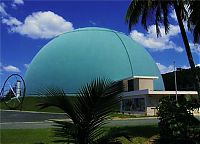|
BONUS (Boiling Nuclear Superheater)
|

|


|

|
The decommissioned Boiling Nuclear Superheater
(BONUS) reactor, located northwest of Rincón, Puerto
Rico, was developed as a prototype nuclear power
plant to investigate the technical and economic feasibility
of the integral boiling-superheating concept. This
small-scale nuclear reactor produced saturated steam
in the central portion of the reactor core, superheated it
in four surrounding “superheater” sections of the same
core, and then used the superheated steam in a direct
loop to drive a turbine generator.
It was one of only two boiling-water superheater
reactors ever developed in the United States. The
reactor was designed to be large enough to evaluate
the major features of the integral boiling-superheating
concept realistically without the high construction and
operating costs associated with a large plant.
Construction of the began in 1960 through a
combined effort of the U.S. Atomic Energy Commission
and Puerto Rico Water Resources Authority. The
reactor first achieved a controlled nuclear chain reaction
on April 13, 1964. It underwent a series of criticality
tests and then was operated experimentally at various
power levels, first as a boiler and later as an integral
boiler-superheater. Operation at full power (50 megawatts
of thermal energy) and full temperature (900 F
[482 °C] steam) was achieved in September 1965, and
tests demonstrated satisfactory operation at 10 percent
over power in November 1965.
Operation of the BONUS reactor was terminated in
June 1968 because of technical difficulties and the
ensuing need for high-cost modifications. The Puerto
Rico Water Resources Authority decommissioned the
reactor between 1969 and 1970. During decommissioning,
all special nuclear materials (fuel) and certain
highly activated components (e.g., control rods and
shims) were removed to the mainland, all piping
systems were flushed, the reactor vessel and associated
internal components within the biological shield
were entombed in concrete and grout, and systems
external to the entombment were decontaminated.
Many contaminated and activated materials were
placed in the main circulation pump room beneath
the pressure vessel and entombed in concrete.
General decontamination of the reactor was performed
with the goal of meeting unrestricted use criteria in all
accessible areas of the building. Residual radioactive
materials remaining in the structure were isolated or
shielded to protect site visitors and workers. During
subsequent years, more radioactive contamination
was identified in portions of the building, and additional
cleanup and shielding activities were conducted in the
1990s and early 2000s.
6 files, last one added on Oct 29, 2005
Album viewed 601 times
|
|
|
|
|
|
|
